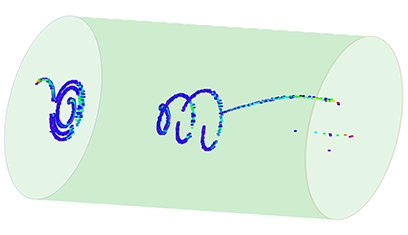
Professor (FRIB)
Joined the laboratory in 1994
Education and training
- PhD, Nuclear Physics University of Caen, France 1987
Research focus
- Experimental nuclear physics
Contact information
Links
Research
The focus of my research is centered on the study of exotic nuclei and the most efficient ways to unravel their properties. It is now well established that these radioactive nuclei have very different properties than the stable ones. Their structures, shapes, and modes of excitation can reveal new phenomena, such as halos or molecular states for instance, that are essential to our understanding of the forces that bind nuclei together via comparison with theoretical models. Finding the most sensitive and relevant experimental methods to reveal these phenomena has been the focus of my career since its beginning.
There are several “tools” available to study the properties of nuclei, but those I am concentrating my research on all involve nuclear reactions. When it comes to exotic nuclei, however, they can only be produced in the laboratory as particle beams and they are usually the heavier partner in a reaction pair. This inverse kinematics situation has important implications on the techniques used to detect and characterize the particles emitted after the reaction. The two techniques I am actively pursuing are nucleon removal reactions at high energy, and low energy reactions using a novel type of detector called an active-target time projection chamber (AT-TPC).

Biography
I was born and raised in Normandy, France, and first pursued the ambition of becoming an engineer. However, near the end of my undergraduate studies, I discovered and fell in love with nuclear physics, and decided to instead become a scientist to study the nucleus of atoms. After completing my PhD in France, I came across the Atlantic ocean as a postdoc at the National Superconducting Cyclotron Laboratory, located on the campus of Michigan State University, and have enjoyed working in this laboratory ever since. Now a Research Professor at the Facility for Rare Isotope Beams, my research interests have not changed, but the tools and techniques I use to achieve them have progressed tremendously. I am heading the Active Target Time Projection Chamber (AT-TPC) research group, with the focus of using low energy reactions to study the structure of rare unstable nuclei that are difficult to produce in large quantities. This new type of experimental technique uses a gas volume as both a target and detector medium, which enables to visualize nuclear reactions, and deduce structure characteristics of the reaction products from their kinematical properties.
How students can contribute as part of my research team
Students are essential to any research team. In my group, they are involved in all aspects of my scientific activities, including contributions to the concept of new detector developments, the planning and proposing of experiments, the setup and operation during beam time, as well as the very important phase of data analysis and publication of results. The AT-TPC is also the subject of a large international collaboration, with experimental campaigns performed with groups from FRIB and other laboratories. Students actively participate in these campaigns, and they are essential to their success. The unique capabilities of the AT-TPC, combined with the new radioactive beams soon available at FRIB, provide unmatched opportunities to study rare isotopes of unknown properties, and further our understanding of nuclear forces.
Scientific publications
- Low energy nuclear physics with active targets and time projection chambers, D. Bazin, T. Ahn, Y. Ayyad, S. Beceiro-Novo, A. O. Macchiavelli, W. Mittig, J. S. Randhawa, Progress in Particle and Nuclear Physics, Volume 114, (2020) 103790
- Spectroscopy of 33Mg with knockout reactions, D. Bazin et al., Phys. Rev. C 103, 064318 (2021)

